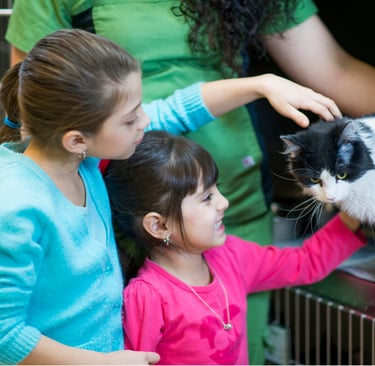First-time cat owner? Here’s what to expect - common mistakes and how to build a happy life with your cat
New to cat ownership? Learn the most common challenges first-time cat owners face and practical tips to raise a healthy, happy, well-adjusted cat.
7/22/20253 min read


Getting a cat for the first time: common challenges and How to overcome them
Thinking about getting a cat for the first time? Here’s what to expect — from the most common challenges new cat parents face to how you can build a happy, healthy relationship with your new feline friend.
Adopting or buying a cat can be the start of a wonderful journey. Cats are loving, intelligent, and independent creatures — but that doesn’t mean caring for one is simple, especially if you’ve never shared your home with a cat before.
In this article, we’ll go over the main difficulties first-time cat owners usually encounter and how to make the transition smoother for both you and your pet.
Expectations vs. reality: cats aren’t mini dogs
One of the first mistakes new cat owners make is expecting cat behavior to be similar to a dog’s. Cats have their own personalities — and while they may seem more independent, they still crave attention, affection, and proper care.
What to expect:
Cats thrive on routine and dislike sudden changes.
They’re selective with affection (and may show love in subtle ways).
They need mental stimulation and environmental enrichment — even in small spaces.
Adjusting to a new home
For those who’ve never lived with cats, the adaptation period can be stressful. Your cat may hide, meow at night, refuse food, or avoid contact.
How to make it easier:
Set up a quiet room for the first few days with a bed, litter box, food, and water.
Respect your cat’s timing — don’t force interaction.
Let them explore at their own pace.
Consider using synthetic pheromones (like Feliway) to reduce stress.
The litter box: trickier than It seems
Most cats naturally know how to use a litter box, but placement, cleanliness, or the wrong type of litter can cause “accidents” around the house.
Practical tips:
Place the box in a quiet, easily accessible spot, away from food and water.
Choose a litter your cat actually likes (unscented is usually best).
Scoop daily and replace the litter frequently.
If you have multiple cats, aim for one box per cat plus one extra.
Scratching furniture and sofas
Scratching is normal — it’s how cats mark territory, sharpen claws, and release tension. But for first-time owners, watching a brand-new couch being shredded can be shocking.
Solution:
Offer scratching posts of different heights, materials, and positions.
Place them near areas your cat already likes to scratch.
Use catnip spray to attract your cat to the post.
Temporarily protect furniture with covers or double-sided tape.
Lack of environmental enrichment
Indoor cats need stimulation to stay healthy and happy. Without it, they can get bored, gain weight, or even develop signs of depression.
What to offer:
Interactive toys, tunnels, and feather wands.
Shelves or perches so they can observe from above.
Simple cardboard boxes (a classic favorite).
Short daily play sessions with you — consistency matters more than duration.
Feeding and hydration mistakes
Many new owners don’t realize cats naturally drink very little water, which can lead to urinary or kidney problems. Others unknowingly feed them human food or unbalanced diets.
Recommendations:
Invest in a high-quality cat food suited to your cat’s age and health.
Offer wet food regularly to boost hydration.
Try a water fountain — most cats love running water.
Never feed onion, garlic, chocolate, or milk — they’re toxic to cats.
Neglecting preventive health care
Some new owners only visit the vet when something seems wrong. But prevention is key to a long, healthy life.
Essential care:
Annual vaccinations (core and rabies).
Deworming and flea/tick control.
Spaying or neutering (prevents disease and unwanted behavior).
Routine checkups — even if your cat seems perfectly fine.
Understanding cat body language
People used to dogs often misread feline signals. A wagging tail, for example, means irritation — not happiness.
Learn the basics:
Purring = usually contentment, but can also indicate pain.
Ears back = discomfort or fear.
Meows = communication attempts (each cat has its own “language”).
Showing the belly = trust, but not always an invitation to pet!
Travel and environmental changes
Unlike dogs, cats don’t handle change very well. Even a short trip can cause stress, and moving houses requires extra care.
How to handle it:
For trips, consider hiring a pet sitter or using a cat boarding service.
During moves, keep your cat confined to a calm, familiar room.
Introduce the new environment gradually, using familiar objects.
Building trust takes time (But It’s worth It!)
Many new owners expect instant affection. But most cats take time to open up and feel safe.
The secret:
Respect your cat’s pace and boundaries.
Keep a consistent, predictable routine.
Associate your presence with positive moments (play, treats, affection).
In time, you’ll have one of the most rewarding relationships you can imagine.
Owning a cat is a learning journey - and a beautiful one
Getting a cat for the first time can be challenging — but it’s also deeply rewarding. The early hurdles are just part of the adjustment for both of you.
With patience, knowledge, and love, you’ll soon be fluent in “cat language” and sharing a warm, lasting bond with your new four-legged friend.
Health
Tips for a healthy and balanced life.
© 2025. All rights reserved.
Well-being
Privacy Policy
Terms and conditions
